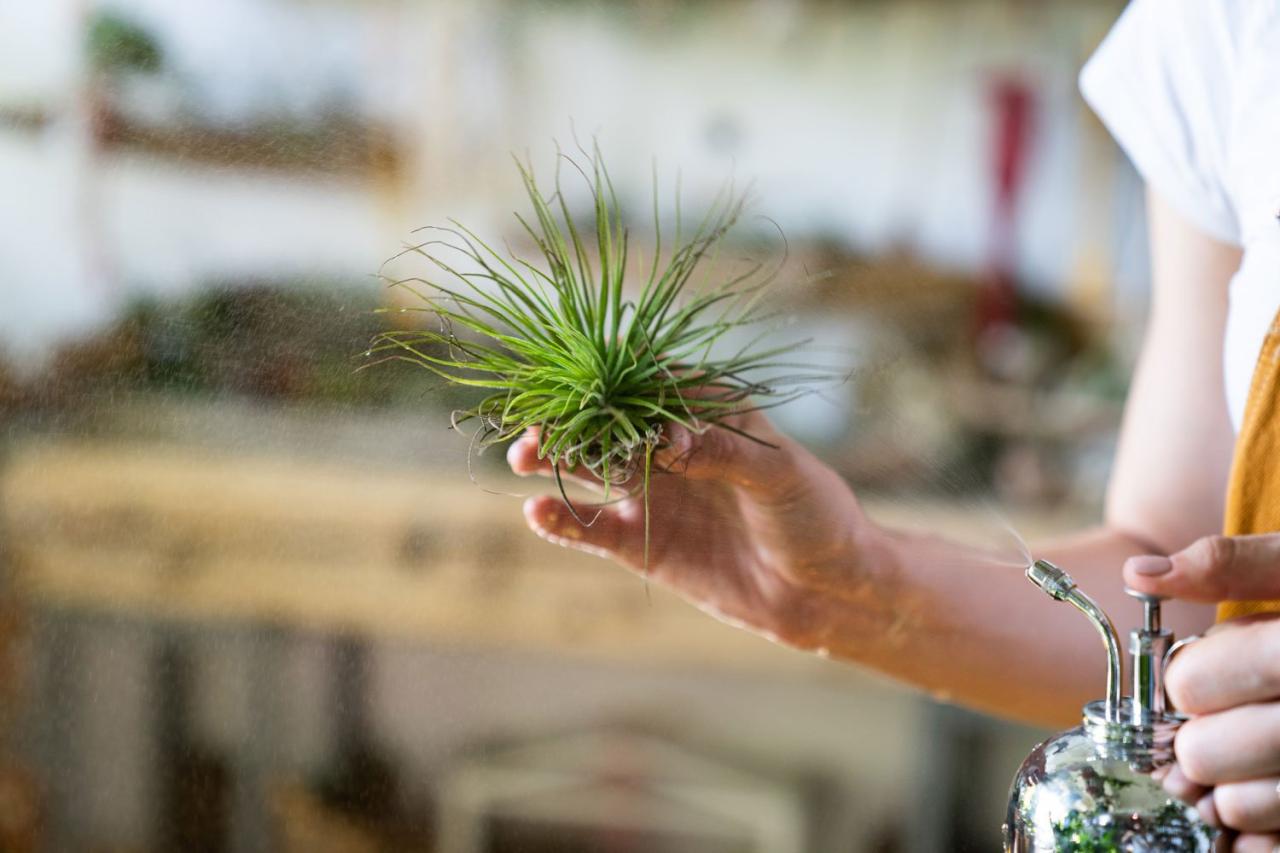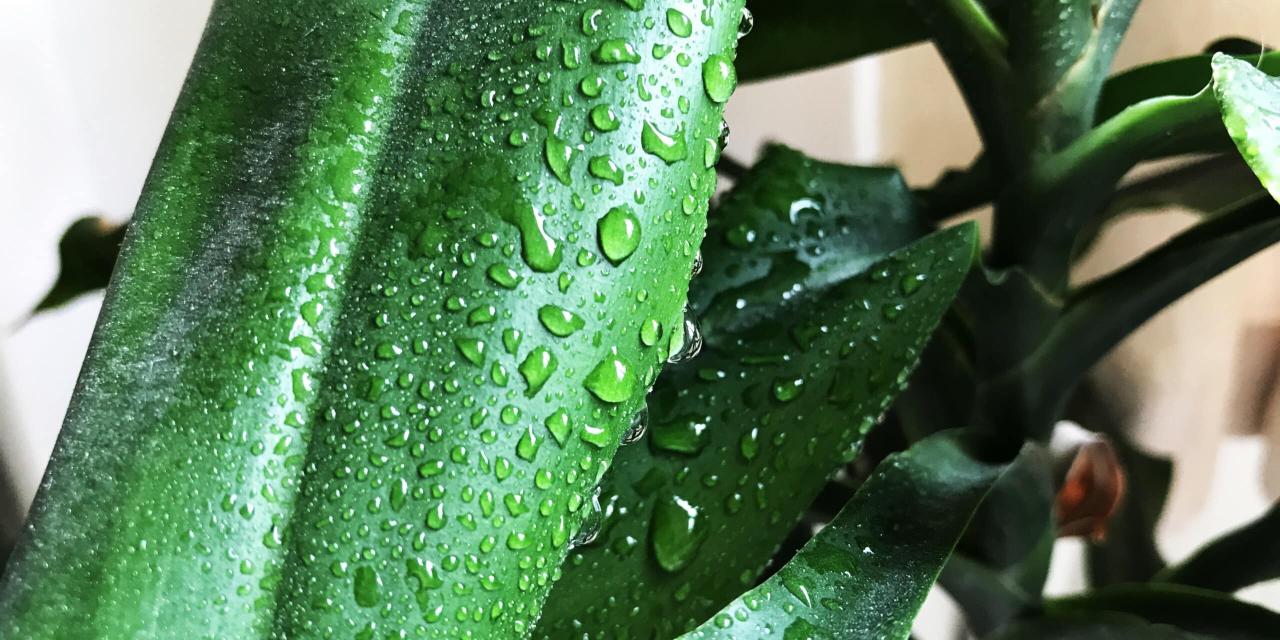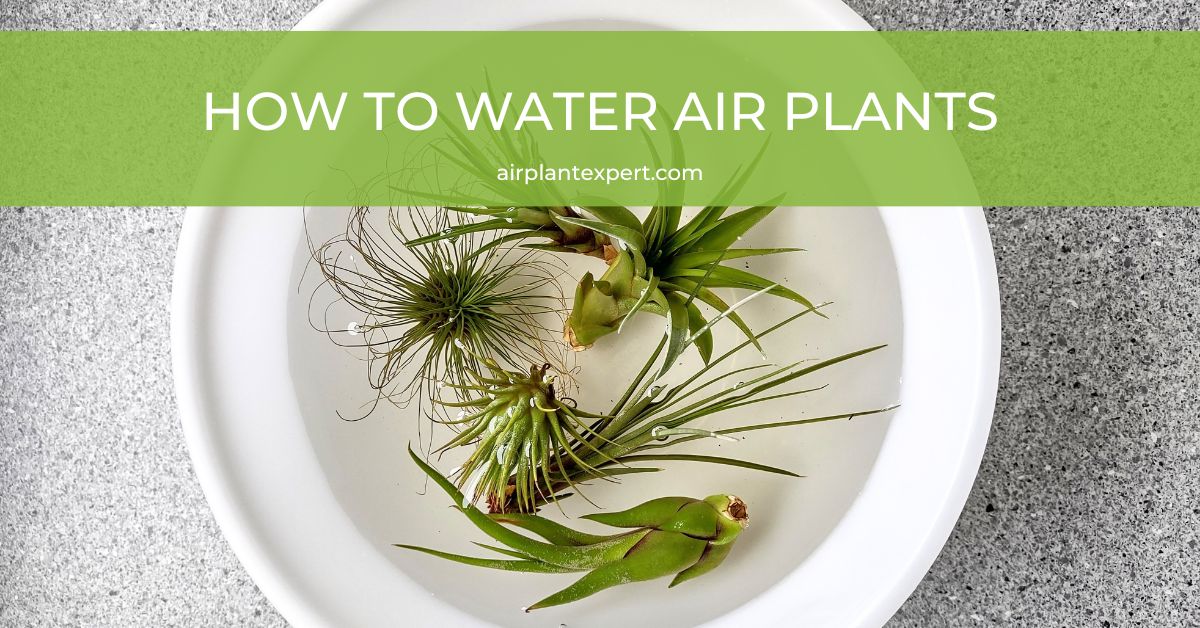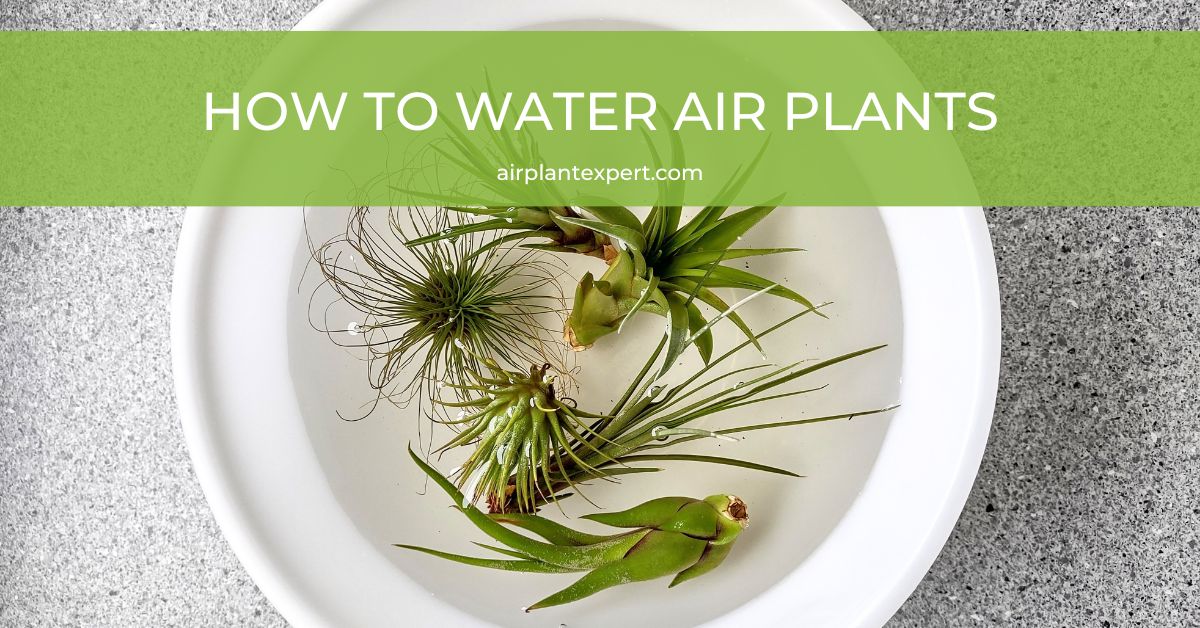The Pros and Cons of Misting Air Plants: Air plants, also known as epiphytes, are fascinating botanical wonders that thrive without traditional soil. These unique plants absorb moisture and nutrients from the air, making them a popular choice for indoor gardens.
One common practice among air plant enthusiasts is misting, which involves spraying water directly onto the plant’s leaves. While misting is often considered a simple and effective watering method, it’s crucial to understand both its benefits and potential drawbacks.
This article delves into the pros and cons of misting air plants, exploring the optimal misting frequency, the best time of day to mist, and alternative watering methods. We’ll also discuss the importance of using filtered water and the risks associated with over-misting, such as root rot and fungal diseases.
By understanding the nuances of misting, you can ensure that your air plants receive the care they need to thrive.
Introduction to Air Plants
Air plants, also known as epiphytes, are fascinating botanical wonders that thrive without soil. These unique plants have captivated plant enthusiasts for their unconventional growth habits and captivating beauty. Air plants are not parasitic, meaning they don’t draw nutrients from their host plants.
While misting air plants can provide temporary hydration, it often leads to overwatering and root rot. A more effective and natural approach is to use rainwater, which replicates the plants’ natural environment. The Benefits of Using Rainwater for Air Plants discusses the advantages of this method, including its pH balance and lack of harmful chemicals.
Ultimately, understanding the pros and cons of misting and exploring alternative watering methods like rainwater can lead to healthier and happier air plants.
Instead, they possess remarkable adaptations that allow them to absorb moisture and nutrients directly from the air.
Air Plant Habitats and Growth Habits
Air plants are native to tropical and subtropical regions of the Americas, from the southern United States to Argentina. They are commonly found in diverse habitats, including rainforests, deserts, and even rocky cliffs. Their adaptability is evident in their ability to thrive in a variety of environments, from humid rainforests to arid deserts.Air plants are epiphytes, meaning they grow on other plants for support but do not rely on them for nourishment.
While misting air plants offers a refreshing and convenient way to hydrate them, it can also create a breeding ground for pesky gnats. To prevent these unwanted visitors, ensure proper drainage and avoid overwatering. If you’re already dealing with a gnat infestation, check out How to Prevent Gnats from Coming Back in Your Plants for effective solutions.
By taking these precautions, you can enjoy the benefits of misting your air plants without attracting unwanted pests.
They often attach themselves to tree branches, rocks, or even telephone wires. Their aerial roots, unlike typical roots, are primarily used for anchoring and absorbing moisture from the air.
Air Plant Adaptations
Air plants have evolved unique adaptations that enable them to survive without soil.
- Trichomes:Air plants possess specialized structures called trichomes, which are tiny, hair-like structures covering their leaves. These trichomes act like miniature sponges, absorbing moisture and nutrients from the air, fog, and even dew.
- Photosynthesis:Air plants perform photosynthesis, the process of converting sunlight into energy, through their leaves. This adaptation allows them to obtain the energy they need for growth without relying on soil-based nutrients.
Air plants are known for their ability to absorb water and nutrients from the air. The trichomes on their leaves act as tiny sponges, drawing in moisture from the atmosphere. They are particularly adept at absorbing moisture from fog, dew, and even rain.
Pros of Misting

Misting air plants is a common practice among enthusiasts, and for good reason. It provides numerous benefits that contribute to their overall health and well-being. This section explores the advantages of misting and how it contributes to optimal air plant care.
Hydration and Nutrient Absorption
Misting plays a crucial role in hydrating air plants, as they lack traditional roots for absorbing water from the soil. The fine mist provides a direct source of moisture, replenishing the water they lose through transpiration. Additionally, misting can help with nutrient absorption.
Air plants absorb nutrients from the air, and misting can deliver these nutrients directly to their leaves.
Promoting Healthy Growth
Regular misting helps maintain optimal humidity levels, which is essential for air plant growth. Air plants thrive in environments with high humidity, and misting helps create a humid microclimate around them. This moisture encourages healthy growth and prevents dehydration, allowing them to flourish.
Maintaining Humidity Levels
Air plants are epiphytes, meaning they grow on other plants and absorb moisture from the air. They require high humidity levels to thrive. Misting helps maintain these levels, especially in dry environments. By replicating their natural habitat, misting creates a humid microclimate around the plants, ensuring they receive the moisture they need to thrive.
Cons of Misting
While misting air plants can be beneficial, excessive misting can lead to several drawbacks that can negatively impact their health.
Root Rot and Fungal Diseases
Excessive misting creates a constantly damp environment that can promote the growth of harmful bacteria and fungi. These microorganisms can thrive in the moist conditions and eventually lead to root rot, a condition that damages the plant’s roots and prevents them from absorbing nutrients.
Root rot is a serious problem that can eventually kill the air plant.
- Symptoms of root rot include:discoloration of the roots, a mushy texture, and a foul odor.
- Fungal diseases can also manifest as:spots or lesions on the leaves, wilting, and a powdery or moldy appearance.
Using Tap Water for Misting
Using tap water for misting can expose air plants to harmful chemicals and minerals that can accumulate on their surfaces and impede their ability to absorb nutrients. These chemicals can include chlorine, fluoride, and other impurities that are commonly found in tap water.
- Chlorine and fluoride can damage the delicate leaves of air plants and hinder their growth.
- Mineral deposits can form on the surface of the plant, obstructing their ability to absorb water and nutrients.
It is essential to use filtered water, rainwater, or distilled water for misting air plants to avoid these potential problems.
Mineral Deposits
Even filtered water can contain small amounts of minerals that can accumulate on the surface of air plants over time. These deposits can appear as white or brown spots and can interfere with the plant’s ability to photosynthesize.
- Mineral deposits can make the plant look unsightly and can also block the stomata, which are tiny pores on the leaves that allow for gas exchange.
- To remove mineral deposits, gently wipe the leaves with a damp cloth or soak the plant in distilled water for a few hours.
Alternative Watering Methods
While misting is a common practice for air plants, it’s not the only way to provide them with the moisture they need. Several alternative watering methods can be more effective and convenient, depending on your specific needs and plant preferences.
Soaking
Soaking is considered the most effective way to water air plants. This method allows the plants to fully absorb moisture, ensuring their roots are adequately hydrated.
- Procedure:To soak your air plants, simply fill a bowl or sink with lukewarm water and submerge the plants for 15-30 minutes. Ensure the entire plant is submerged, allowing the water to penetrate the trichomes and reach the roots.
- Frequency:The frequency of soaking depends on the air plant species, environmental conditions, and the plant’s size. However, generally, soaking once every 1-2 weeks is sufficient.
- Advantages:
- Provides a thorough hydration, ensuring all parts of the plant are adequately moistened.
- Allows the plant to absorb water slowly and naturally, reducing the risk of overwatering.
- Can be done in a short period, making it a convenient method.
- Disadvantages:
- May require more time and effort compared to misting.
- Can be messy if not done carefully.
Humidity Trays
Humidity trays are an excellent way to create a moist environment for air plants, promoting healthy growth.
- Procedure:Place a layer of pebbles or marbles in a tray or dish, and fill it with water. Place the air plants on top of the pebbles, ensuring the plants are not directly in contact with the water. The water will evaporate, creating a humid microclimate around the plants.
- Frequency:The water level in the tray should be checked regularly and refilled as needed. Depending on the size of the tray and the evaporation rate, you may need to refill it every few days or once a week.
- Advantages:
- Provides a consistent level of humidity, mimicking the plant’s natural environment.
- Requires minimal maintenance, as the water level only needs to be refilled occasionally.
- Can be aesthetically pleasing, adding a decorative element to your home.
- Disadvantages:
- May not be as effective as soaking in providing direct hydration to the plant.
- Requires a dedicated space for the tray and may not be suitable for all environments.
Environmental Considerations

Providing the right environment for air plants is crucial for their health and well-being. Air plants thrive in specific conditions, and misting alone might not be enough to meet their needs. This section will delve into the importance of adequate airflow and light, explore how different environmental factors influence misting effectiveness, and offer tips for creating an optimal environment for air plants.
Airflow and Light
Air plants need good airflow to thrive. Proper airflow helps with air circulation, which is essential for their respiration and prevents fungal growth. Air plants are epiphytes, meaning they grow on other plants without taking nutrients from them. In their natural habitat, they are exposed to open air and sunlight.
This means they are adapted to a constantly changing environment, with air currents that keep them cool and dry.
- Airflow:A well-ventilated space, like a windowsill or a porch, is ideal. Avoid placing them in enclosed spaces where air becomes stagnant.
- Light:Air plants require bright, indirect light. They should be exposed to at least four hours of sunlight daily, but avoid direct sunlight, which can scorch their leaves.
Influence of Environmental Factors on Misting
The effectiveness of misting can be influenced by various environmental factors. These factors can affect how well the water is absorbed by the air plant and how quickly it dries.
- Humidity:In humid environments, air plants absorb moisture more readily. High humidity levels can also reduce the drying time after misting, which is important to prevent fungal growth.
- Temperature:Warmer temperatures increase the rate of evaporation, which can dry out air plants quickly. This makes misting more frequent in warmer climates or during the summer months.
- Air Circulation:Poor airflow can lead to excessive moisture build-up, increasing the risk of fungal infections. Good air circulation helps to dry the plants after misting, preventing them from becoming waterlogged.
Creating an Optimal Environment
Creating the right environment for air plants involves a combination of factors, including airflow, light, and humidity.
- Airflow:Place air plants in a well-ventilated area. Consider using a fan to increase air circulation, especially in humid environments.
- Light:Provide bright, indirect light. Avoid placing air plants in direct sunlight, especially during the hottest part of the day. Consider using a grow light if natural light is limited.
- Humidity:If the humidity is low, you can create a more humid environment by placing a humidifier near your air plants. You can also group them together to create a microclimate that helps retain moisture.
Troubleshooting Misting Issues

Misting air plants can be a simple and effective watering method, but it requires some understanding of the nuances to avoid common problems. Overwatering and under-watering are two main issues that can arise, and recognizing the signs and implementing solutions is crucial for maintaining healthy air plants.
Identifying Overwatering and Under-watering Signs, The Pros and Cons of Misting Air Plants
Identifying the signs of overwatering and under-watering is essential for taking appropriate action. Overwatering is often characterized by:
- Air plants becoming soft, mushy, or limp.
- Development of brown or black spots on the leaves.
- A foul odor emanating from the plant.
- The presence of mold or mildew on the plant or in the surrounding environment.
Under-watering, on the other hand, can lead to:
- Air plants becoming dry and brittle.
- Leaves turning brown or yellow.
- The plant becoming shriveled or wilted.
Addressing Overwatering Issues
Overwatering is a common problem that can be addressed by:
- Reducing the frequency of misting.
- Ensuring proper drainage by allowing the plant to dry completely between mistings.
- Using a different watering method, such as soaking, to control the amount of water absorbed by the plant.
- Increasing air circulation around the plant to promote drying.
Addressing Under-watering Issues
Under-watering can be resolved by:
- Increasing the frequency of misting.
- Soaking the plant in water for 30 minutes to an hour once a week.
- Using a humidifier to increase the humidity in the surrounding environment.
Recognizing Unhealthy Air Plants
Besides overwatering and under-watering, air plants can also exhibit other signs of unhealthy conditions, such as:
- Pests: Inspect the plant for insects like mealybugs, aphids, or scale. These pests can be removed with a cotton swab dipped in rubbing alcohol or a mild insecticidal soap.
- Disease: Signs of disease include discoloration, spots, or rot. If you suspect disease, isolate the plant to prevent spreading and consult a gardening expert for treatment options.
- Nutrient Deficiencies: Air plants need nutrients, and a lack of them can lead to stunted growth or discoloration. You can address this by using a diluted fertilizer solution specifically designed for air plants.
Last Word
Misting air plants can be a beneficial practice, but it’s not a one-size-fits-all approach. By understanding the pros and cons of misting, and by employing alternative watering methods when necessary, you can create an environment that promotes healthy growth for your air plants.
Remember to observe your plants closely, adjust your watering techniques as needed, and enjoy the beauty and resilience of these unique botanical wonders.
FAQ Resource: The Pros And Cons Of Misting Air Plants
What are the signs of over-misting in air plants?
Over-misting can lead to root rot and fungal diseases. Signs include brown or mushy leaves, a foul odor, and a slimy texture.
Can I use tap water to mist my air plants?
While tap water may seem convenient, it often contains minerals and chemicals that can build up on the plant’s surface and hinder its ability to absorb moisture. Filtered or distilled water is generally recommended for misting air plants.
How often should I mist my air plants?
The frequency of misting depends on factors such as the climate, plant species, and humidity levels. Generally, misting every 1-2 days is sufficient, but you may need to mist more frequently in dry environments.
